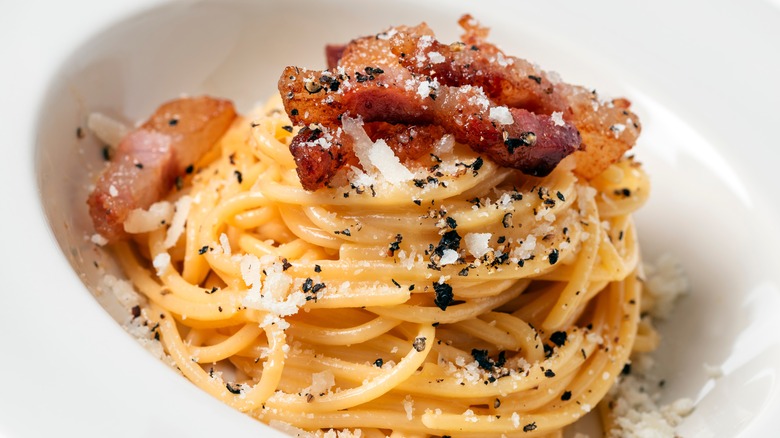No One Can Agree On The Origins Of Pasta Alla Gricia
The simple and versatile pasta alla gricia is one of Italy's quintessential pasta dishes, TV chef Giada De Laurentiis explains on her blog, Giadzy. Yet, unlike pasta all' Amatriciana (named after the central Italian town of Amatrice) or pasta carbonara (popularly thought to have been invented during World War II during the liberation of Rome), the origins of pasta alla gricia are a little more uncertain.
Pasta alla gricia is traditionally made with fresh black pepper, pecorino romano cheese, and guanciale, which is salt-cured pork jowl. If that sounds familiar, it should. All the ingredients found in pasta alla gricia are also found in some of Rome's most popular and long-lived pasta dishes, including Amatriciana and carbonara. Pasta alla gricia is commonly seen as a precursor to these later pasta specialties, which add tomatoes or egg to the recipe, respectively.
The name of the pasta sauce, gricia, gives some hint as to its origin, but reports are conflicting. Some believe the name of the dish comes from the Roman word "grici," originally used to refer to bakers, who may have been involved in developing the dish. Grici (or gricio) also came to mean local food sellers, who may have stocked the common ingredients people could use to make the pasta. However, some more compelling theories argue the dish was named after the area where it was invented.
Pasta alla gricia vs. pasta all' Amatriciana
Grisciano, a small town in central Italy, is commonly seen as the namesake for pasta alla gricia. The province is on the outskirts of the Lazio region, where most people agree that pasta alla gricia was born, and also located a mere 9.5 miles from Amatrice, where the very similar pasta all'Amatriciana sprang up. The similarities between pasta all' Amatriciana and pasta alla gricia have convinced some that locals from Amatrice started with the simpler dish, simply adding tomatoes at a later date to create the more widely known Amatriciana sauce.
Another convincing theory credits shepherds from the Lazio region with inventing the dish, since it can be made with easily accessible ingredients like guanciale, dry pasta, pecorino, and pepper. Shepherds roaming the countryside may have been a key part of how the dish spread across Italy, eventually coming to Rome. Whatever the dish's origin, it remains a homey and filling meal (Giada De Laurentiis referred to the pasta as a "hug in a bowl" on Instagram) that can be easily modified depending on what ingredients you have access to.

